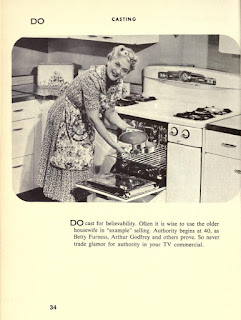Wherever he might be today, I hope Mr. McMahan isn't watching 21st century television. When it comes to commercials, it's not a pretty sight.
Wednesday, January 23, 2019
Words from Our Sponsor
Nearly as long as we've had television, we've had commercials. Nowadays, we have so many of them that some frustrated viewers have cut the cord on broadcast TV. Thanks to the good folks of The Media History Digital Library, I recently time-traveled back to 1957, where author Harry Wayne McMahan's book The Television Commercial: How to Create and Produce Effective TV Advertising was instructing sponsors and ad men how to put their best feet forward in this still-young medium.
Some of his book's concerns clearly belong to that now-bygone era; I think the debate over live versus filmed commercials has been pretty decisively settled. But many of his comments -- don't make exaggerated claims for the product, don't talk down to viewers -- are still pertinent. As for his caution that commercials lose effectiveness when they are repeated too often, I wonder what he would say about one 60-minute program I saw recently in which the same ad aired seven times during that single broadcast. Or, for that matter, how that hour-long program, shorn of its nearly incessant commercial interruptions, would have run 37 minutes.
Wherever he might be today, I hope Mr. McMahan isn't watching 21st century television. When it comes to commercials, it's not a pretty sight.
Wherever he might be today, I hope Mr. McMahan isn't watching 21st century television. When it comes to commercials, it's not a pretty sight.
Friday, January 4, 2019
Preserving the Republic (Studio)
The illustrations, including movie stills, poster art, and related ephemera, are probably the chief asset of this coffee-table-type book. The text I found less impressive. Chapters offer somewhat superficial overviews of topics such as Western heroes, serials, and stuntmen, leaning pretty heavily on previously published material. The well-documented relationship between studio head Herbert J. Yates and his favorite leading lady, Vera Ralston, is discussed at some length, but in the end I didn't feel as though I'd learned much that I didn't already know.
There are also some errors film buffs won't have any trouble spotting, including the misspelled names of actresses Phyllis Coates and Mabel Normand. And while I appreciated the coverage of Gail Russell and Anne Jeffreys in the chapter on Republic's leading ladies, how do you put out an entire book on this studio with nary a mention of funny lady Judy Canova?
It's a shame to begin a new year talking about a book I can only marginally recommend. I'll try to do better next time out.


